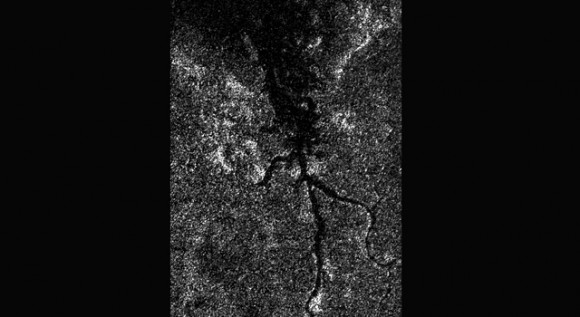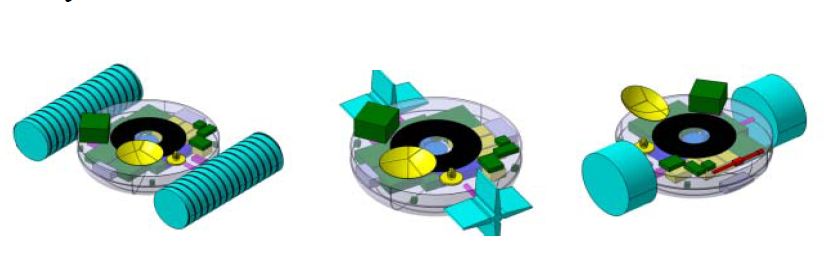Ribber Duckie
Posted: Thu Dec 13, 2012 8:17 pm
http://www.universetoday.com/98964/cry-me-a-nile-like-river-of-liquid-hydrocarbons-on-titan/#more-98964 wrote:
Cry Me a Nile-Like River of Liquid Hydrocarbons on Titan
by Nancy Atkinson on December 13, 2012
<<Titan is appearing more Earth-like all the time (yes, a very cold, and early version of Earth), as now the Cassini spacecraft has spotted what appears to be a miniature extraterrestrial version of the Nile River: a river valley on Saturn’s moon Titan that extends from what looks like ‘headwaters’ out to a large sea. Not only is it a riverbed, but it appears to be filled with liquid; likely very cold hydrocarbons such as ethane or methane.Scientists deduce that the river is filled with liquid because it appears dark along its entire extent in the high-resolution radar image, indicating a smooth surface. It is the first time images have revealed a river system this vast and in such high resolution anywhere beyond Earth. “Though there are some short, local meanders, the relative straightness of the river valley suggests it follows the trace of at least one fault, similar to other large rivers running into the southern margin of this same Titan sea,” says Jani Radebaugh, a Cassini radar team associate at Brigham Young University, USA. “Such faults – fractures in Titan’s bedrock – may not imply plate tectonics, like on Earth, but still lead to the opening of basins and perhaps to the formation of the giant seas themselves.” While the Earthly Nile River is 6,650 kilometers (4,132 miles) long, Titan’s big river is about 400 km long.
Titan is the only other world we know of that has stable liquid on its surface. While Earth’s hydrologic cycle relies on water, Titan’s equivalent cycle involves hydrocarbons. Cassini’s visual and infrared mapping spectrometer confirmed liquid ethane at a lake in Titan’s southern hemisphere known as Ontario Lacus in 2008. “This radar-imaged river by Cassini provides another fantastic snapshot of a world in motion, which was first hinted at from the images of channels and gullies seen by ESA’s Huygens probe as it descended to the moon’s surface in 2005,” said Nicolas Altobelli, ESA’s Cassini Project Scientist.>>
http://www.universetoday.com/97611/paddleboat-mission-to-titan-proposed/ wrote:
Paddleboat Mission to Titan Proposedby Nancy Atkinson, Sept. 27, 2012Click to play embedded YouTube video.Click to play embedded YouTube video.With surface temperature at -178º C, Titan’s environment is too cold for life
as we may know it, but its environment is rich in the building blocks of life.
<<Is sending a boat to Titan an outlandish idea? Maybe, said a group of European scientists and engineers, but they’re working on a plan. The Titan Lake In-situ Sampling Propelled Explorer (TALISE) proposes a sending an instrument-laden boat-probe to Saturn’s largest moon that could be propelled by paddles, inflatable wheels or screws. The probe would land in the middle of Ligeia Mare – Titan’s biggest lake, near the moon’s north pole — then set sail for the coast, taking scientific measurements along the way. “The main innovation in TALISE is the propulsion system,” says Igone Urdampilleta from SENER, an engineering company in Spain and a member of the TALISE team. “This allows the probe to move, under control, from the landing site in the lake, to the closest shore. The displacement capability would achieve the obtaining of liquid and solid samples from several scientific interesting locations on Titan’s surface such as the landing place, along the route towards the shore and finally at the shoreline.”
In a presentation at the European Planetary Science Congress on September 27, 2012, the TALISE team says that since Titan has a thick atmosphere, a diameter between that of Earth and the planet Mercury, and a network of seas, lakes and rivers, it is in many respects more like a planet than a moon. And it’s time to go there and do a little in-situ science. The principle objective of the mission would be to characterize Titan’s environment and the chemical composition of the lakes and terrain.
While the Cassini-Huygens mission landed the Huygens probe on Titan in 2005, it transmitted data for only about 90 minutes after touchdown. The TALISE mission would last six months to a year. The Cassini orbiter has confirmed that lakes, seas and rivers of liquid hydrocarbons cover much of the Titan’s northern hemisphere, and these hydrocarbons may rain down on the surface, forming the frigid liquid bodies. “The chemical composition of the lakes of Titan is still not well determined,” the TALISE team wrote in their abstract. “The detection of other compounds and the investigation of influence of both, photochemistry and the atmosphere on the chemical composition of liquids of Titan lakes remain challenging in the absence of in situ measurements. Therefore, it is next step to understand the Titan lakes environment, its relationship with the climate behavior, the surrounding solid substrate and analyze the organic inventory including the possibility of prebiotic compounds.”
The actual configuration of the boat is still under consideration, and they are considering various in-situ propulsion methods through the liquid hydrocarbon seas. In addition to paddle wheels, screw propulsion and inflatable wheels, they are also looking at tank wheels, air propeller, liquid propeller and a hovercraft design.>>

